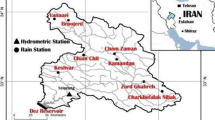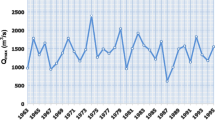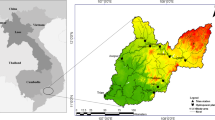Abstract
Flood is becoming an intensive hydro-climatic issue at the Kelantan River basin in Malaysia. Univariate frequency analysis would be unreliable due to multidimensional behaviour of flood, which often demands multivariate flow exceedance probabilities. The joint distribution analysis of multiple interacting flood characteristics, i.e. flood peak, volume and duration, is very useful for understanding critical hydrologic behaviour at a river basin scale. In this paper, a copula-based methodology is incorporated for multivariate flood frequency analysis for the 50-year annual basis flood characteristics of Kelantan River basin at Guillemard bridge station in Malaysia. Investigation reveals that the Lognormal (2P), Johnson SB-4P and Gamma-3P are selected as marginal distributions for the flood peak flow, volume and duration series. Several bivariate families such as mono-parametric, bi-parametric (i.e. mixed version) and rotated version of Archimedean copulas and also the elliptical copula are introduced to cover a large dependence pattern of flood characteristics. The dependence parameter of bivariate copulas is estimated by the method of moments (MOM) based on the inversion of Kendall’s tau and maximum pseudo-likelihood estimator. To analytically validate and recognize most parsimonious copulas, GOF test and Cramer–von Mises distance statistics (Sn) with the parametric bootstrap method are employed. The Gaussian copula is identified as the most justifiable model for joint modelling of the flood peak–volume and peak–duration combination for MOM-based parameter estimation procedure. Similarly, the Frank copula is selected as the best-fitted structure for modelling peak–duration combination based on MPL estimators, but the MOM estimator recognized Gaussian copula as most suitable for peak–volume pair. Furthermore, the best-fitted copulas are used for obtaining the joint and conditional return periods of the flood characteristics.





















Similar content being viewed by others
References
Abdulkareem JH, Sulaiman WNA (2015) Trend analysis of precipitation data in flood source areas of Kelantan River basin, Malaysia. In: The 3rd international conference in water resources, ICWR-2015, pp 174–188
Adamowaski K (1985) Nonparametric kernels estimation of flood frequencies. Water Resour Res 21(11):1585–1590
Adamowski K (1989) A monte Carlo comparison of parametric and nonparametric estimations of flood frequencies. J Hydrol 108:295–308
Adnan NA, Atkinson PM (2011) Exploring the impact of climate and land use changes on streamflow trends in a monsoon catchment. Int J Climatol 31:815–831
Akaike H (1974) A new look at the statistical model identification. IEEE Trans Autom Control AC 19(6):716–722
Alina B (2018) Copula Modeling for world’s biggest competitors. Master Thesis, Amsterdam School of Economics, University of Amsterdam
Anderson TW, Darling DA (1954) A test of goodness of fit. J Am Stat Assoc 49(268):765–769
Bain LJ, Engelhardt M (1991) Statistical Analysis of Reliability and Life-Testing Models. Deker, New York
Blazkova S, Beven K (2004) Flood frequency estimation by continuous simulation of subcatchmnets rainfalls and discharges with the aim of improving dam safety assessments in a large basin in the Czech Republic. J Hydrol 292:153–172
Bobee B, Rasmussen PF (1994) Statistical analysis of annual flood series. In: Menon J (ed) Trend in hydrology, vol 1. Council of Scientific Research Integration, New Delhi, pp 117–135
Calver A, Lamb R (1995) Flood frequency estimation using continuous rainfall-runoff modelling. Phys Chem Earth 20(479):483
Chan NW (1997) Institutional arrangement of flood hazard management in Malaysia: an evaluation using criteria approach. Disasters 21:206–222
Cong RG, Brady M (2011) The interdependence between rainfall and temperature: copula analyses. Sci World J 2011, 405675
Conover WJ (1999) Practical nonparametric statistics. Wiley, New York
Constantino M, Larran M, Brebbia CA (2008) Computational finance and its applications III, Volume 41 of WIT transactions on information and communication technologies, WIT Press, 2008
Correia FN (1987) Multivariate partial duration series in flood risk analysis. In: Singh VP (ed) Hydrologic frequency modelling. Reidel, Dordrecht, pp 541–554
Cunnane C (1978) Unniased plotting positioning-a review. J Hydrol 37:205–222
Cunnane C (1987) Review of statistical models for flood frequency estimation. In: Singh VP (ed) Hydrologic frequency modeling. Reidel, Dordrecht, pp 49–95
Daneshkhan A, Remesan R, Omid C, Holman IP (2016) Probabilistic modelling of flood characteristics with parametric and minimum information pair-copula model. J Hydrol 540:469–487
De Michele C, Salvadori G (2003) A generalized Pareto intensity-duration model of storm rainfall exploiting 2-copulas. J Geophys Res 108(D2):4067. https://doi.org/10.1029/2002JD002534
De Michele C, Salvadori G, Canossi M, Petaccia A, Rosso R (2005) Bivariate statistical approach to check the adequacy of dam spillway. J Hydrol Eng 10(1):50–57
DID (Drainage and Irrigation Department) (2000) Annual flood report of DID for Peninsular Malaysia. Unpublished report. DID, Kuala Lumpur
DID (Drainage and Irrigation Department Malaysia) (2003) Annual flood report of DID for Peninsular Malaysia. Unpublished report. DID, Kuala Lumpur
DID (Drainage and Irrigation Department Malaysia) (2004) Annual flood report of DID for Peninsular Malaysia. Unpublished report. DID, Kuala Lumpur
Dooge JCE (1986) Looking for hydrologic laws. Water Resour Res 22(9):465–485
Escalante C, Raynal JA (1998) Multivariate estimation of floods: the trivariate gumble distribution. J Stat Comput Simul 61:313–340
Escalante C, Raynal JA (2008) Trivariate generalized extreme value distribution in flood frequency analysis. Hydrol Sci 53(3):550–567
Fan L, Zheng Q (2016) Probabilistic modelling of flood events using the entropy copula. Adv Water Resour 97:233–240
Farrel PJ, Stewart KR (2006) Comprehensive study of tests for normality and symmetry: extending the Spiegelhalter test. J Stat Comput Simul 2006(76):803–816. https://doi.org/10.1080/10629360500109023
Favre A-C, Adlouni SE, Perreault L, Thiemonge N, Bobee B (2004) Multivariate hydrological frequency analysis using copulas. Water Resour Res. https://doi.org/10.1029/2003WR002456
Fisher NI, Switzer P (2001) Graphical assessments of dependence: is a picture worth 100 tests? Am Stat 55(3):233–239
Gaál L, Szolgay J, Kohnová S, Hlavčová K, Parajka J, Viglione A, Blöschl G (2015) Dependence between flood peaks and volumes: a case study on climate and hydrological controls. Hydrol Sci J 60(6):968–984
Genest C, Boies JC (2003) Detecting dependence with Kendall plots. Am Stat 57(4):275–284
Genest C, Favre A-C (2007) Everything you always wanted to know about copula modelling but were afraid to ask. J Hydrol Eng 12:347–368
Genest C, Rémillard B (2008) Validity of the parametric bootstrap for goodness-of-fit testing in semiparametric models. Ann l’Inst Henri Poincare Prob Stat 44:1096–1127
Genest C, Rivest LP (1993) Statistical inference procedures for bivariate Archimedean copulas. J Am Stat Assoc 88(423):1034–1043
Genest C, Ghoudi K, Rivest LP (1995) A semiparametric estimation procedure of dependence parameters in multivariate families of distributions. Biometrika 82(3):543–552
Genest C, Favre AC, Beliveau J, Jacques C (2007) Metaelliptical copulas and their use in frequency analysis of multivariate hydrological data. Water Resour Res 43:W09401. https://doi.org/10.1029/2006WR005275
Genest C, Rémillard B, Beaudoin D (2009) Goodness-of-fit tests for copulas: a review and a power study. Insur Math Econ 44:199–214
Goel NK, Seth SM, Chandra S (1998) Multivariate modelling of flood flows. J Hydraul Eng 124(2):146–155
Graler B, Berg MJV, Vandenberg S, Petroselli A, Grimaldi S, Baets BD, Verhost NEC (2013) Multivariate return periods in hydrology: a critical and practical review focusing on synthetic design hydrograph estimation. Hydrol Earth Syst Sci 17:1281–1296
Grimaldi S, Serinaldi F (2006) Asymmetric copula in multivariate flood frequency analysis. Adv Water Resour 29:1155–1167
Gringorten II (1963) A plotting rule of extreme probability paper. J Geophys Res 68(3):813–814
Hannan EJ, Quinn BG (1979) The determination of the order of an autoregression. J R Stat Soc Ser B Stat Methodol 41:190–195
Hassan AAG (2004) Growth, Structural change and regional inequality in Malaysia. Ashgate Publishing Ltd, Malaysia
Hosking JRM, Walis JR (1987) Parameter and quantile estimations for the generalized Pareto distributions. Technometrics 29(3):339–349
Hosking JRM, Wallis JR, Wood EF (1985) Estimation of the general extreme value distribution be the method of probability weighted moments. Technometrics 27(3):251–261
Hussain STPR, Ismail H (2013) Flood frequency analysis of Kelantan River Basin, Malaysia. World Appl Sci J 28(12):1989–1995. https://doi.org/10.5829/idosi.wasj.2013.28.12.1559
Jamaliah J (2007) Emerging Trends of Urbanization in Malaysia [online]. http://www.statistics.gov.my/eng/images/stories/files/journalDOSM/V104ArticleJamaliah.pdf. Accessed 9 Dec 2018
Joe H (1997) Multivariate models and dependence concept. CRC Press, Boca Raton
Karmakar S, Simonovic SP (2008) Bivariate flood frequency analysis. Part-1: determination of marginal by parametric and non-parametric techniques. J Flood Risk Manag 1:190–200
Karmakar S, Simonovic SP (2009) Bivariate flood frequency analysis. Part-2: a copula-based approach with mixed marginal distributions. J Flood Risk Manag 2(1):1–13
Katz RW, Parlang MB, Naveau P (2002) Statistics of extremes in hydrology. Adv Water Resour 25(8):1287–1304
Kendall MG (1975) Rank correlation methods, 4th edn. Charles Griffin, London, p 1975
Kim KD, Heo JH (2002) Comparative study of flood quantiles estimation by nonparametric models. J Hydrol 260:176–193
Klein B, Schumann AH, Pahlow M (2011) Copulas-New risk assessment methodology for dam safety, flood risk assessment and management. Springer, pp. 149–185.
Klein B, Pahlow M, Hundecha Y, Schumann A (2010) Probability analysis of hydrological loads for the design of flood control system using copulas. J Hydrol Eng ASCE 15:360–369
Kojadinovic I, Yan J (2010) Modeling multivariate distributions with continuous margins using the copula R package. J Stat Softw 34(9):1–20
Kojadinovic I, Yan J, Holmes M (2011) Fast large-sample goodness-of-fit tests for copulas. Stat Sin 21:841–871
Kong XM, Huang GH, Fan YR, Li YP (2015) Maximum entropy-Gumbel–Hougaard copula method for simulation of monthly streamflow in Xiangxi river, China. Stoch Environ Res Risk A 29:833–846
Krstanovic PF, Singh VP (1987) A multivariate stochastic flood analysis using entropy. In: Singh VP (ed) Hydrologic frequency modelling. Reidel, Dordrecht, pp 515–539
Lawrence D, Paquet E, Gailhard J, Fleig AK (2014) Stochastic semi-continuous simulations for extreme flood estimations in catchments with combined rainfall-snowmelt flood regimes. Nat Hazard Earth Syst 14:1283–1298
Li F (2016) Modeling covariate-contingent correlation and tail-dependence with copulas. https://arxiv.org/pdf/1401.0100.pdf
Ljung GM, Box GEP (1978) On a measure of lack of fit in time series models. Biometrika 65:297–303
Madsen H, Rasmussen PF, Rosbjerg D (1997) Comparison of annual maximum series and partial duration series methods for modelling extreme hydrologic events. 1. At-site modelling. Water Resour Res 33(4):747–757
Mann HB (1945) Nonparametric test against trend. Econometrics 13:245–259
Manner H (2007) Estimation and model selection of copulas with an application to exchange rates. Department of Quantitative Economics, Maastricht University, Maastricht
Manner H (2010) Modelling assymetric and time-varying dependence. https://cris.maastrichtuniversity.nl/portal/files/667227/guid-ae8195ad-cf0b%20-4744-8bb1-6a44fbe10fe7-ASSET1.0. Accessed 15 May 2019
Mathwave Technologies (2004–2017) http://mathwave.com/en/home.html
McNeil AJ, Frey R, Embrechts P (2015) Quantitative risk management. Princeton University Press, Princeton. ISBN: 978-0-691-03407-16627-8
MMD (2007) Malaysian Meteorological Department (MMD). Report on heavy rainfall that caused floods in Kelantan and Terengganu. Unpublished report. MMD, Kuala Lumpur
Moriasi DN, Arnold JG, Van Liew MW, Bingner RL, Harmel RD, Veith TL (2007) Model evaluation guidelines for systematic quantification of accuracy in watershed simulations. Trans ASABE 50(3):885–900
Nadarajah S, Shiau J (2005) Analysis of extreme flood events for the Pachang River, Taiwan. Water Resour Manag 19:363–375
Nashwan MS, Ismail T, Ahmed Kamal (2018) Flood susceptibility assessment in Kelantan river basin using copula. Int J Eng Technol 7(2):584–590
Nelsen RB (2006) An introduction to copulas. Springer, New York
Owen CEB (2008) Parameter estimation for the beta distribution. All Thesis and Disertation, p 1614. https://scholarsarchive.byu.edu/etd/1614
Poulin A, Huard D, Favre AC, Pugin S (2007) Importance of tail dependence in bivariate frequency analysis. J Hydrol Eng 12(4):394–403
Rahman HAA, Ibrahim NA, Abdul Hamid AA, Abdul Hamid THT (2018) Effect of 2014 massive flood on well water qualities: a case study on Kelantan River basin, Malaysia. J Water Land Dev 38:127–136. https://doi.org/10.2478/jwld-2018-0049
Rakhecha PR, Singh VP (2009) Applied hydrometeorology. Capital Publishing Company, New Delhi
Rao AR, Hameed KH (2000) Flood frequency analysis. CRC Press, Boca Raton
Razawi S, Vogel R (2018) Pre-whitening of hydroclimatic time series? Implications for inferred change and variability across time scales. J Hydrol 557(2018):109–115
Reddy MJ, Ganguli P (2012a) Bivariate flood frequency analysis of upper Godavari River flows using archimedean copulas. Water Resour Manag. https://doi.org/10.1007/s11269-012-0124-z
Reddy MJ, Ganguli P (2012b) Risk assessments of hydro-climatic variability on ground water levels in the Manjra basin aquifer in India using Archimedean copulas. J Hydrol Eng. https://doi.org/10.1061/(ASCE)HE.1943-5584.0000564
Reddy MJ, Ganguli P (2013) Probabilistic assessments of flood risks using trivariate copulas. Theor Appl Climatol 111:341–360
Renard B, Lang M (2007) Use of a Gaussian copula for multivariate extreme value analysis: some case studies in hydrology. Adv Water Resour 30:897–912
Requena AI, Flores I, Mediero L, Garrote L (2016) Extension of observed flood series by combining a distributed hydro-meteorological model and a copula-based model. Stoch Environ Res Risk Assess 30:1363–1378. https://doi.org/10.1007/s00477-015-1138-x
Saklar A (1959) Functions de repartition n dimensions et leurs marges. Publ Inst Stat Univ Paris 8:229–231
Salvadori G (2004) Bivariate return periods via-2 copulas. J R Stat Soc Ser B 1:129–144
Salvadori G, De Michele C (2004) Frequency analysis via copulas: theoretical aspects and applications to hydrological events. Water Resour Res 40:W12511. https://doi.org/10.1029/2004WR003133
Salvadori G, De Michele C (2006) Statistical characterization of temporal structure of storms. Adv Water Resour 29:827–842
Salvadori G, De Michele C (2007) On the use of copulas in hydrology: theory and practices. J Hydrol Eng 12:369–380
Salvadori G, De Michele C (2010) Multivariate multiparameters extreme value models and return periods: a Copula approach. Water Resour Res. https://doi.org/10.1029/2009WR009040
Santhosh D, Srinivas VV (2013) Bivariate frequency analysis of flood using a diffusion kernel density estimators. Water Resour Res 49:8328–8343. https://doi.org/10.1002/2011WR0100777
Schmidt T (2007) Coping with Copulas. In: Rank J (ed) Copulas: from theory to application to finance, chap. 1. Risk Books, London, pp 3–34
Scholz FW, Stephens MA (1987) K-sample Anderson–Darling tests. J Am Stat Assoc 82(399):918–924
Schwarz GE (1978) Estimating the dimension of a model. Ann Stat 6(2):461e464
Schweizer B, Wolff EF (1981) On parametric measures of dependence for random variables. Ann Stat 9:879–885
Sen Z (1999) Simple risk calculations in dependent hydrological series. Hydrol Sci J 44(6):871–878
Serinaldi F (2015) Dismissing return periods! Stoch Environ Res Risk Assess 29(4):1179–1189
Shiau JT (2003) Return period of bivariate distributed hydrological events. Stoch. Environ. Res. Risk Assess. 17(1–2):42–57
Shiau JT (2006) Fitting drought duration and severity with two dimensional copulas. Water Resour Manag 20(5):795–815
Silverman BW (1986) Density estimation for statistics and data analysis, 1st edn. Chapman and Hall, London
Singh J, Knapp HV, Demissie M (2004) Hydrologic modeling of the Iroquois River watershed using HSPF and SWAT. ISWS CR 2004-08. Illinois State Water Survey, Champaign, Ill. www.sws.uiuc.edu/pubdoc/CR/ISWSCR2004-08.pdf. Accessed 10 Apr 2019
Song S, Singh VP (2010) Metaelliptical copulas for drought frequency analysis of periodic hydrologic data. Environ Res Hazard Assess 24(3):425–444
Sraj M, Bezak N, Brilly M (2014) Bivariate flood frequency analysis using the copula function: a case study of the Litija station on the Sava River. Hydrol Process. https://doi.org/10.1002/hyp.10145
Tang Y, Huynh VN, Lawry J (2015) Integrated uncertainty in knowledge modelling and decision making- 4th International Symposium, Proceedings, LNAI 9376, Springer-Verlag, 2015.
Tosunoglu F, Kisi O (2016) Joint modelling of annual maximum drought severity and corresponding duration. J Hydrol. https://doi.org/10.1016/j.jhydrol.2016.10.018
Veronika BM, Halmova D (2014) Joint modelling of flood peak discharges, volume and duration: a case study of the Danube River in Bratislava. J Hydrol Hydromech 62(3):186–196
Wan I (1996) Urban growth determinants for the state of Kelantano of the state’s policy makers. Penerbitan Akademik Fakulti Kejuruteraan dan Sains Geoinformasi Buletin Ukur 7:176–189
Wang C, Ni-Bin Chang N-B, Yeh G-T (2009) Copula-based flood frequency (COFF) analysis at the confluences of river systems. Hydrol Process 23:1471–1486
Wooldridge S, Kalma J, Kuczera G (2001) Parameterisation of a simple semi-distributed model for assessing the impact of land-use on hydrologic response. J Hydrol 254:16–32
Xu Y, Huang G, Fan Y (2015) Multivariate flood risk analysis for Wei River. Stoch Environ Res Risk Assess. https://doi.org/10.1007/s00477-015-1196-0
Yue S (1999) Applying the bivariate normal distribution to flood frequency analysis. Water Int 24(3):248–252
Yue S (2000) The bivariate lognormal distribution to model a multivariate flood episode. Hydrol Process 14:2575–2588
Yue S (2001) A bivariate gamma distribution for use in multivariate flood frequency analysis. Hydrol Process 15:1033–1045
Yue S, Rasmussen P (2002) Bivariate frequency analysis: discussion of some useful concepts in hydrological applications. Hydrol Process 16:2881–2898
Yue S, Wang CY (2004) A comparison of two bivariate extreme value distribution. Stoch Environ Res Risk A 18:61–66
Yue S, Ouarda TMBJ, Bobee B, Legendre P, Bruneau P (1999) The Gumbel mixed model for flood frequency analysis. J Hydrol 226(1–2):88–100
Zhang L (2005) Multivariate hydrological frequency analysis and risk mapping. Doctoral dissertation, Beijing Normal University
Zhang L, Singh VP (2006) Bivariate flood frequency analysis using copula method. J Hydrol Eng 11(2):150
Zhang L, Singh VP (2007) Trivariate flood frequency analysis using the Gumbel-Hougaard copula. J Hydrol Eng 12(4):431–439
Zhang R, Xi Chen, Cheng Q, Zhang Z, Shi P (2016) Joint probability of precipitation and reservoir storage for drought estimation in the headwater basin of the Huaihe River, China. Stoch Environ Res Risk Assess 30:1641–1657
Author information
Authors and Affiliations
Corresponding author
Ethics declarations
Conflict of interest
This manuscript exhibited no conflict of interest.
Rights and permissions
About this article
Cite this article
Latif, S., Mustafa, F. Bivariate flood distribution analysis under parametric copula framework: a case study for Kelantan River basin in Malaysia. Acta Geophys. 68, 821–859 (2020). https://doi.org/10.1007/s11600-020-00435-y
Received:
Accepted:
Published:
Issue Date:
DOI: https://doi.org/10.1007/s11600-020-00435-y




